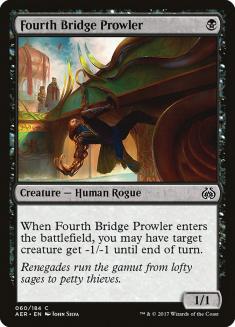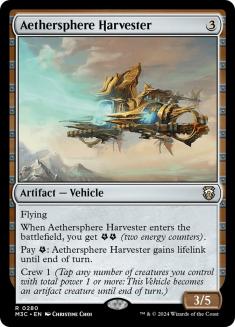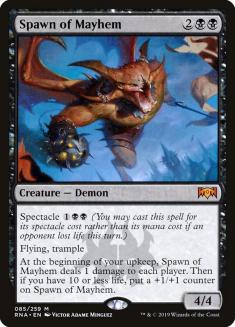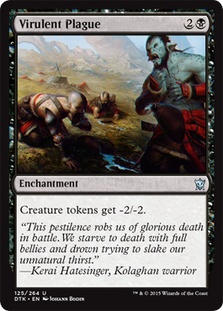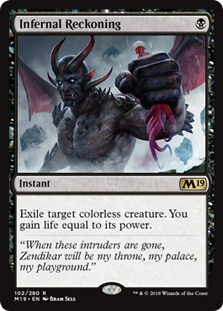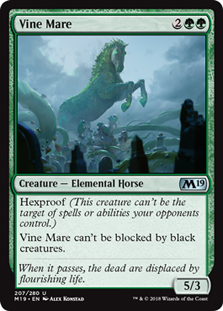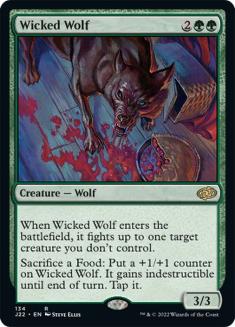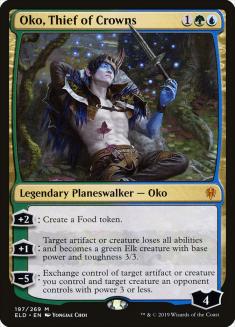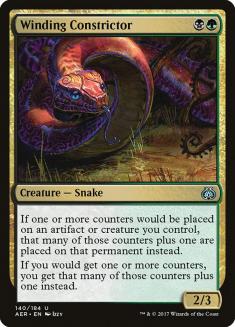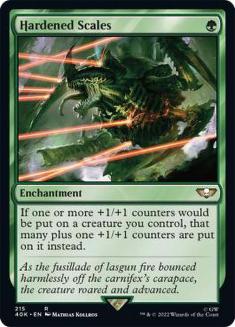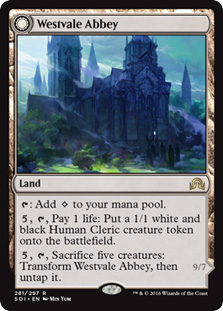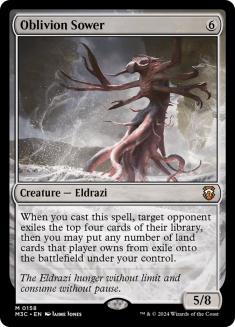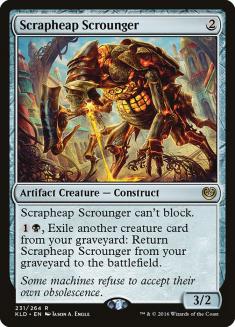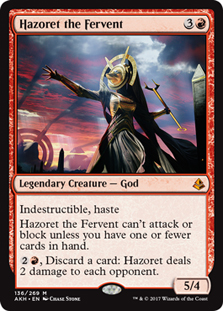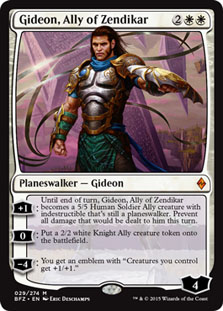Last week was Pioneer Week on Magic Online, with eight Pioneer Players Tour Qualifiers in seven days. As of Sunday afternoon as I’m writing this, one PTQ is still ongoing and we have decklists posted for the first seven.
Top 8 Data (56 Total Decks)
Mono-Black Aggro – 20 (35.7%)
Llanowar Elves Green – 17 (30.4%)
Subarchetypes:
- Simic Aggro – 7
- Gruul Aggro – 8
- Simic / Mono-Green Devotion – 2
Field of the Dead – 11 (19.6%)
Subarchetypes:
- Bant Field – 5
- Golgari Field – 4
- Mono-Green Field – 2
Other – 8 (14.3%)
Subarchetypes:
- Lotus Field Combo – 2
- Simic Nexus – 1
- Simic Delirium – 1
- Golgari Soulflayer – 1
- Jeskai Control – 1
- Selesnya Knights – 1
- Azorius Flash – 1
PTQ Winners
- Mono-Black Aggro – 2
- Simic Aggro – 2
- Golgari Field – 1
- Simic Devotion – 1
- Selesnya Knights – 1
One notable thing is these numbers aren’t that different from what happens if you look at everyone who missed Top 8 on tiebreakers. The main difference is the “Other” category takes a chunk of Mono-Black Aggro’s share to balance the categories of Mono-Black Aggro, Llanowar Elves Green, Field of the Dead, and Other at around 25% each. This amazingly implies that not only is Mono-Black Aggro the broadly best deck, but that it also overperforms at the top levels of the format. Simic Aggro is the other notable overperformer, doubling its share as you jump from the just outside the Top 8 bracket to Top 8 decklists, and then again doubling its share moving to the PTQ winners’ metagame.
Pillar #1: Mono-Black Aggro
Creatures (24)
- 4 Bloodsoaked Champion
- 4 Scrapheap Scrounger
- 4 Night Market Lookout
- 3 Spawn of Mayhem
- 4 Knight of the Ebon Legion
- 1 Rankle, Master of Pranks
- 4 Murderous Rider
Lands (24)
Spells (12)
Sideboard

Mono-Black is fundamentally the same deck it was when it won a PTQ at the start of the month, or when it won the Season Two Invitational at SCG CON Winter. This list maximizes the new tech, but the new stuff is all largely flex slot numbers that vary wildly between lists.
The early week tech that has faded out is Fourth Bridge Prowler. This was almost exclusively a card aimed at eating Llanowar Elves, and Field of the Dead’s spike in popularity in the last week or two has both chewed into that slice of the metagame and forced Mono-Black Aggro to cut Prowler and react to different pressures.
The tech that has remained fairly steady over time is Aethersphere Harvester, largely because it is aimed at the Mono-Black mirror. If you played during the Aether Revolt Mardu Vehicles peak, you probably remember the function of Aethersphere Harvester. It’s merely acceptable as a proactive tool, but even without extra energy it is one of the few cards that can swing an early game disparity fast enough to matter. It is still exploitable by dying to bigger removal and is still your second-best Vehicle, so large numbers aren’t an option, but the possibility of being a high-impact play keeps it around. Flying isn’t the worst ability against Field of the Dead either.
Which bridges to the next development. Spawn of Mayhem has been eating into the Rankle, Master of Pranks and Murderous Rider expensive slots as the format turns into more clocking Field of the Dead over their initial Zombie tokens. We will get to the different Field of the Dead archetypes later, but at the least against Golgari, being a four-cost three-drop plays extremely well against their Abrupt Decays. If their removal is Supreme Verdict, the Spawn option is a little less exciting than the Rankle one, but their lack of early removal often means Scrapheap Scrounger is good for enough damage that you just need any flyer to close out.
You would think a monocolored deck would have issues finding good sideboard cards, but the options are super-deep in Pioneer’s black cards. Virulent Plague is a hate card that Field of the Dead decks can answer, but the combination of Thoughtseize, hate cards, and straining your opponent’s raw resource count has been historically effective. Infernal Reckoning is just rebuying some old Core Set 2019 Standard tech, this time using it to fight Vehicles and Scrapheap Scounger in Mono-Black Aggro mirrors instead of using it as a tool for Dimir decks to fight those decks. There has been almost no copies of Ensoul Artifact around, and some of that may be splash damage on this exact card.
Overall, it’s really hard to argue with the raw math behind Mono-Black Aggro. It has the most results at every level, the highest density of top-tier cards, and the only real weakness is that you have “can’t block” syndrome on the draw and need to target specific hands to change that dynamic. Only one of the seven PTQs I looked at wasn’t flooded with this archetype. I also struggle to see a world where some significant portion of this shell doesn’t remain a key player, even if it has to slant more aggressive or more defensive due to other factors. If you want a stable base in Pioneer, be “part of the problem” and win with the most popular deck.
Pillar #2: Llanowar Elves Green
Creatures (24)
- 4 Llanowar Elves
- 4 Elvish Mystic
- 1 Rhonas the Indomitable
- 4 Steel Leaf Champion
- 2 Gilded Goose
- 4 Lovestruck Beast
- 3 Questing Beast
- 2 Wicked Wolf
Planeswalkers (4)
Lands (19)
Spells (13)

Creatures (27)
- 3 Llanowar Elves
- 2 Scavenging Ooze
- 3 Elvish Mystic
- 4 Jadelight Ranger
- 4 Hydroid Krasis
- 3 Voracious Hydra
- 4 Gilded Goose
- 4 Wicked Wolf
Planeswalkers (8)
Lands (21)
Spells (4)

Creatures (27)
- 4 Llanowar Elves
- 2 Ghor-Clan Rampager
- 4 Elvish Mystic
- 4 Goblin Rabblemaster
- 2 Vine Mare
- 4 Lovestruck Beast
- 3 Questing Beast
- 4 Bonecrusher Giant
Lands (22)
Spells (11)
Sideboard

The Once Upon a Time plus Llanowar Elves section is still a solid pillar of the metagame despite some shifts within the archetype. The initially popular Devotion shell has fallen behind two-color aggro decks, but all three decks have moved in similar directions. Honestly, at this point the lines are blurring so much between them that you may as well be choosing between single specific cards within them more than any strategic shifts. The nuance between Llanowar Elves into this three-drop versus that three-drop is only so big.
The biggest maindeck shift has been the adoption of more resilient threats. Jamming the biggest threats faster than your opponent was the key to old green mirrors, but both Field of the Dead and Mono-Black Aggro can punish you if they draw more interaction than you have threats. You need to have things that are both solidly proactive and can punish your opponent for moving towards a reactive plan.
Vine Mare is a narrow solution for a three-deck format. The Mono-Black Aggro deck can block it with Mutavault and Smuggler’s Copter, and the Field of the Dead decks can block it with Arboreal Grazer or sweep it away, but it’s not always conveniently answered when it dodges Zombie tokens and Knight of the Ebon Legion. That’s good enough for a Gruul deck slapping an Embercleave somewhere. Rekindling Phoenix is playing a similar role, but is kinda hard to cast. Pioneer mana hasn’t gotten any better for allied color pairs, and Game Trail is still as disgust-inducing as it was in Shadows over Innistrad Standard.
Wicked Wolf hits the Mono-Black Aggro and green deck intersection. Indestructible Ravenous Chupacabra, only the twelfth-best card from Throne of Eldraine, and all the other things you already know about this card being absurd from Throne of Eldraine Standard.
This trend also encompasses the Simic Devotion deck splitting the difference between Mono-Green Devotion and Simic Aggro. Oko, Thief of Crowns; Wicked Wolf; and Hydroid Krasis try to fight against the issues Mono-Green Devotion has with interaction breaking up half of the “combo,” with removal crippling the early battlefield presence needed to fuel Nykthos, Shrine to Nyx or a Thoughtseize taking out your one big threat. Rather than being all-in on Burning-Tree Emissary and the London mulligan, you have staying power. If things shift back to green decks I would want to go back to Vivien, Arkbow Ranger and the all-in builds, but as long as there’s a splash of interaction across the board, the stickier list is better.
Along these lines, there just isn’t Hardened Scales or Winding Constrictor anywhere. The middle ground of interactive and incremental at the cost of resiliency isn’t the right place. The drop-off in Walking Ballista is definitely an exploitable trend and something we will see in the decks just outside the top pillars.
I think green is in a high-variance metagame position right now. Things could break either way for these decks depending on how the rest of the metagame reacts to Field of the Dead and Mono-Black Aggro, since “Elves and threats” has been exploitable in similar ways since the 1990s. Even if green decks are good, there’s no promise the same subarchetypes I’m talking about today are even good. If you like a green deck feel free to play it, and the deck should stay at least a moderate staple of the format, but there are no promises the specific list you choose stays relevant.
Pillar #3: Field of the Dead
Creatures (14)
Lands (27)
- 2 Forest
- 1 Llanowar Wastes
- 2 Swamp
- 2 Overgrown Tomb
- 1 Urborg, Tomb of Yawgmoth
- 1 Woodland Cemetery
- 1 Temple of Malady
- 1 Radiant Fountain
- 1 Jungle Hollow
- 1 Hissing Quagmire
- 1 Westvale Abbey
- 1 Blooming Marsh
- 1 Ifnir Deadlands
- 1 Hashep Oasis
- 1 Field of Ruin
- 1 Blast Zone
- 4 Field of the Dead
- 1 Castle Garenbrig
- 1 Castle Locthwain
- 2 Fabled Passage
Spells (19)

Creatures (9)
Planeswalkers (4)
Lands (28)
- 2 Forest
- 1 Plains
- 1 Island
- 1 Yavimaya Coast
- 1 Temple Garden
- 1 Breeding Pool
- 1 Hallowed Fountain
- 1 Glacial Fortress
- 1 Sunpetal Grove
- 1 Hinterland Harbor
- 1 Temple of Mystery
- 1 Temple of Enlightenment
- 1 Temple of Plenty
- 1 Thornwood Falls
- 1 Blossoming Sands
- 1 Westvale Abbey
- 1 Botanical Sanctum
- 1 Irrigated Farmland
- 1 Scattered Groves
- 1 Field of Ruin
- 1 Blast Zone
- 4 Field of the Dead
- 1 Castle Vantress
- 1 Fabled Passage
Spells (19)

Creatures (12)
Planeswalkers (4)
Lands (28)
Spells (16)

The Top 8 decklists for Field of the Dead are mostly Golgari and Bant, with a solid but smaller chunk of Mono-Green.
The one development all three archetypes can agree on is Westvale Abbey. At first glance it seems win more to leverage five Zombie tokens into a giant flyer, but Ormendahl, Profane Prince negates most of the ways people are trying to beat Field of the Dead. You aren’t racing with any flyer or Questing Beast, you can’t “Falter” with Legion’s End if they just leave up the Westvale Abbey activation, and if one player in a mirror has Abbey and the other doesn’t, the game ends swiftly rather than turning into a Zombie apocalypse. When you are already looking for uniquely named lands to play, including Westvale Abbey is easy upgrade.
The other universal tech is Oblivion Sower as a breaker for the mirror match. This is similar to Aethersphere Harvester where sometimes the card is absolutely unbeatable because it flips a Field of the Dead and you make way more Zombies than they do, but sometimes it hits a random assortment of lands and is just a 5/8 body plus Circuitous Route. Still, something is better than nothing, though one Top 32 Field of the Dead list was Gruul for maindeck Crumble to Dust, which is probably the biggest something you can fire off to win the mirror.
If you want to classify the difference between the three Field of the Dead decks, I would focus on these three cards.
Golgari Field has Tireless Tracker, and it’s just the pin holding all the black threads together. If you have played Modern you can recognize the “seven lands” patterns with Field of the Dead and Scapeshift plus Valakut, the Molten Pinnacle, and one of the traditional Scapeshift issues has always been that any interaction is one less card you can spend hitting seven lands. Golgari Field embraces the midrange half of this and leans on Hour of Promise being a two-for-one and Tireless Tracker to actually hit seven lands while interacting. It’s the Field of the Dead deck you have to beat on some fundamental scale or speed level, not with all-or-nothing silver bullets.
Bant Field with Supreme Verdict is the more traditional variant of this deck. You have only the cards that maximize your ability to get a fast Field of the Dead trigger, the highest-individual-impact interaction, and maybe one or two alternative whammies hanging out somewhere.
Mono-Green Field is kind of a concession, banking on those alternate whammies with extra Nissa’s Pilgrimage support being better than Field of the Dead. Ugin, the Spirit Dragon certainly is against the Llanowar Elves decks, and World Breaker might be better in mirror matches or against Mono-Black Aggro. The Mono-Green Field deck opens itself up to general interaction by going through non-lands, and is significantly less effective against the midrange and control decks that Field of the Dead normally demolishes due to having less Field of the Dead and less land diversity.
I feel like Field of the Dead is a dubious long-term deck in the metagame. It’s more of a constraint on the format, the nail in the coffin on midrange and control decks that are already disadvantaged in the all-threats format. It is extremely powerful, but also exploitable on base levels. How can this deck ever beat a successful combo deck? If people start adapting to Field of the Dead, I would look towards the non-Bant variants. Golgari Field is better if Smuggler’s Copter remains a top choice, but without that card as a major player, an Ugin, the Spirit Dragon build is more exciting.
Contender #1: White or Red Aggro
Creatures (34)
- 4 Knight of the White Orchid
- 4 Boros Elite
- 4 Mardu Woe-Reaper
- 2 Kytheon, Hero of Akros
- 4 Thraben Inspector
- 4 Thalia's Lieutenant
- 4 Benalish Marshal
- 4 Dauntless Bodyguard
- 2 Venerated Loxodon
- 2 Giant Killer
Lands (18)
Spells (8)

Creatures (17)
- 4 Thraben Inspector
- 3 Thalia, Heretic Cathar
- 4 Scrapheap Scrounger
- 4 Toolcraft Exemplar
- 2 Walking Ballista
Planeswalkers (5)
Lands (23)
Spells (15)

Creatures (21)
- 4 Monastery Swiftspear
- 4 Bomat Courier
- 4 Scrapheap Scrounger
- 2 Hazoret the Fervent
- 3 Rekindling Phoenix
- 4 Goblin Chainwhirler
Lands (23)
Spells (16)

Creatures (21)
- 4 Monastery Swiftspear
- 4 Bomat Courier
- 1 Hazoret the Fervent
- 4 Soul-Scar Mage
- 4 Ghitu Lavarunner
- 4 Viashino Pyromancer
Lands (19)
Spells (20)
Sideboard

There’s the traditional white-goes-wide, red-goes-face distinction between Mono-White Aggro and Mono-Red Aggro, but both archetypes are hitting Pioneer from a similar angle with similar decisions. Neither performed amazingly well across the Top 8s, but in the tier just below they were the only consistently successful alternatives to the Big Three pillars.
Choice one is the black splash, with Scrapheap Scrounger being the most common draw to it. The Foreboding Ruins versus Concealed Courtyard shift is a bit of a deal-breaker, but at the same time Unlicensed Disintegration is absurdly good. I don’t have a clear opinion on whether to splash or not in these decks and neither does the data, so I would try it both ways and see what feels best.
Choice two is whether you significantly stretch into the midrange threats. In this case I think there’s a huge difference. Gideon, Ally of Zendikar is too fragile for the hyper-proactive Pioneer metagame and not a huge gain, where Hazoret the Fervent is perfect to bash on green decks and Mono-Black Aggro. White aggro should be built as low to the ground as possible, where red aggro should take its cue from the metagame presence of Field of Ruin pushing it low to the ground. Honestly, the cost to playing small-ball red and sideboarding Hazoret is fairly low, so I’m going to bias in that direction to start and move bigger from there depending on testing.
Creatures (31)
- 4 Knight of the White Orchid
- 4 Thalia's Lieutenant
- 4 Heron's Grace Champion
- 4 Dauntless Bodyguard
- 3 Knight of Grace
- 4 Venerable Knight
- 4 Worthy Knight
- 4 Acclaimed Contender
Lands (20)
Spells (9)

The only white or red aggro deck to even Top 8 a PTQ was Selesnya Knights taking down one of them, a deck brewed and promoted by Sam Black. The core synergy here is Worthy Knight and Thalia’s Lieutenant, a pairing highlighted early in the format, but this list is precisely targeted against Mono-Black Aggro with Knight of Grace and the race-dominating Heron’s Grace Champion. I’ll leave a more detailed breakdown to someone more involved with the deck, but I’ll make the note that the player who won the PTQ was rushing to enter and some of the more questionable card choices like The Circle of Loyalty or sideboard Plains are a result of that rather than tested decisions.
Contender #2: Lotus Field Combo
Creatures (12)
Lands (23)
Spells (25)

The only deck in the “Other” category to put up multiple Top 8s did so at the last minute, with two copies of Lotus Field combo in the same Saturday PTQ Top 8.
The short version of the combo:
- Get Lotus Field on the battlefield.
- Copy it with Thespian’s Stage.
- Use Hidden Strings to untap both the real and copy Lotus Fields for four net mana, or Pore Over the Pages for one net mana and a ton of cards.
- Granted for Omniscience. Cast it with your stacks of mana.
- Granted again for Enter the Infinite.
- Granted again for Jace, Wielder of Mysteries, and win the game.
There is real hate in the format for this deck in the form of Alpine Moon and Damping Sphere, but it’s refreshing to see a bit of the “How can I beat Thoughtseize and Stubborn Denial” question re-cracked as a way to exploit Field of the Dead decks.
Really the solution is the same as how Simic Nexus tried to win early in the format, but with more layers. Use Dig Through Time to refuel against attrition, but also Pore over the Pages. Have Fog and blockers to buy extra turns. And it doesn’t hurt that this mana engine is a land can’t be Thoughtseize’d or Stubborn Denial’ed.
The data for Pioneer Week shows supports for the locked-down but lightly spread format I’ve described the last couple of weeks, but we are starting to see some rays of sunshine. If the late trend against Mono-Black Aggro and Thoughtseize continues, we might see some real exploits for the Llanowar Elves and Field of the Dead decks start to break through. That’s a big “if,” but at least it’s an “if” for now.

